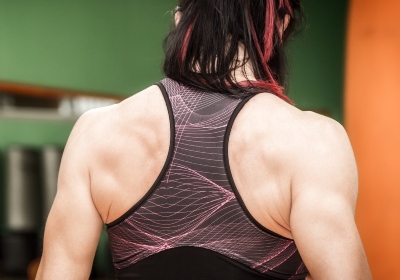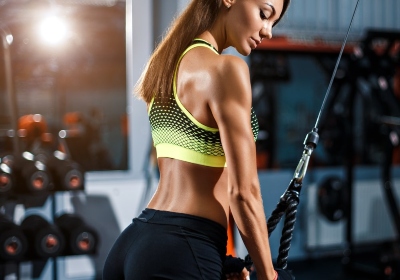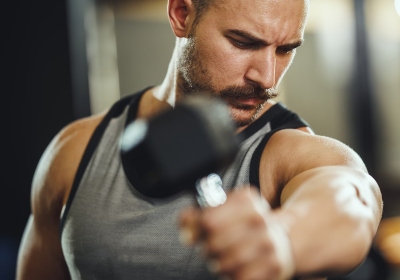VIDEO
Across the Chest Stretch
- Triceps
- Trapezius
- Shoulders
Level:Intermediate
Trainer:Zoey Flores
Equipment:No Equipment
Across the Chest Stretch
- Triceps
- Trapezius
- Shoulders
Level:Intermediate
Trainer:Zoey Flores
Equipment:No Equipment
Bring your right arm across your chest. Place it in decrease of your left elbow when using your left hand to support your arm. Hold on this position for up to 1 minute. Repeat the same actions with the opposite arm.
save to ...
RECOMMENDED FOR YOU
- Biceps
- Gluteus
- Hamstrings
Duaration: 00:49
save to playlist
ARTICLES
The trapezius muscle is a crucial straight broad muscle that is located in a superficial position, in the back part of the neck and the upper back. The trapezius muscle has the shape of a triangle, the base facing the spinal column, and the top - to the acromion of the scapula. These kinds of muscles on both sides of the back together are trapezoidal.
There are three parts of it:
Upper part: Once the spine is fixed and raises the scapula. With a fixed shoulder blade, it straightens the head and neck.
Middle part: When the spine is fixed and the head brings the scapula to the spine. With the contraction of all parts of the muscles, the adduction of the shoulder blades also occurs.
Low part: It downs the shoulder girdle when the spine and head are fixed.
The upper trapezius muscles are trained by raising and lowering the shoulders with weights in the hands (performing shrugs). The lower part is trained by bringing the shoulder blades of the back under load.
Training.
Band Seated Row. Sitting on the floor with your legs extended loop an elastic band around your soles and hold one end in your right hand. Squeezing your shoulder blades and making a twist to the right with your torso, pull the band toward your waist. Then repeat the action to the other side.
Planche. It is an advanced gymnastic exercise. You should have a high level of fitness preparation and strong hands. It is the skill in which your body should be parallel to the ground supported by hands and arms with your legs raised.
S-Leg Pushup. Put your hands and toes on the mat. Keep your arms straight, but don't lock your elbows. Align your feet making the straight line with your arms and core. Inhaling, bend your elbows and lower your chest to the mat slowly. Straighten your arms to lift your core up, exhaling, at the same time lifting one leg off the ground.
P-up Variation. Put your hands and toes on the mat. Keep your arms straight, but don't lock your elbows. Align your feet making the straight line with your arms and core. Inhaling, bend your elbows and lower your chest to the bench slowly. Straighten your arms to lift your core up, exhaling.
Read more
The muscle on the back of your shoulder is called the triceps. Triceps originate from the scapula and humerus and attach to the ulna using the triceps tendon. The triceps muscle does the function of extension in the elbow and acts as an auxiliary in the implementation of other movements in the shoulder. During triceps contraction, the vector of movement is transmitted using the tendon.
The mass fraction of the triceps is approximately 2/3 of the muscles of the shoulder, so its size plays a critical role in the formation of beautiful arms. By focusing on the biceps, and forgetting about the triceps muscle, athletes contribute to getting inharmoniously developed arms.
You shouldn't train your triceps more often than 1-2 times a week. Do not forget that many exercises for the pectoral muscles load the triceps, so make up the training program so that the triceps and pectoral muscles are trained on different and distant days, thus some periodization of the load is achieved.
But in some cases, the triceps can be trained on the same day as the pectorals, since all basic chest exercises involve the triceps and vice versa. This means that if you swing your chest, then the triceps already swing by themselves. To increase efficiency, do triceps workouts of different intensities: light-medium-hard, and so on. Rest for at least 1 week after a hard workout.
In classic splits, the triceps are usually the most overloaded muscle, due to the very specifics of training in split programs. To increase the volume of the triceps muscle, do 8-15 repetitions. The total number of triceps sets (the sum of the sets of all triceps exercises) is 3-6.
The basic exercises for pumping triceps are reverse push-ups on the bench and narrow grip barbell press. In addition, an important exercise is a pull of the upper block with a rope - one of the few that uses the lateral head in the work. Since the mechanics of movements are in many ways similar, it is recommended not to combine the presented exercises, but to alternate.
Training.
Reverse push-ups from the bench. Starting position - heels touch the floor, hands on the bench behind your back. Slowly lower your torso down, linger at the bottom point, then with an explosive force push your body weight up over the bench. The elbows are directed backward. To complicate things, use an extra load by putting the weight on your hips.
Bench press with a narrow grip. It’s the exercise to work out the medial head of the triceps. Lie on a bench (keeping your feet firmly on the floor), grab a barbell or dumbbell with a narrow grip, then lift the weight up. During execution, the elbows should be pressed as close to the body as possible.
Bent over triceps extension. It’s for pumping the long and lateral heads of the triceps. When pulling the arm back, make sure that the elbow does not change position (that is, do not swing the arm back and forth or left and right). Also, watch out for the arch of the back - to do this, keep the abs slightly tense.
Top pulldown with rope. A key exercise for pumping the lateral head of the triceps. The movement should be in the lower plane - that is, do not raise your arms higher than chest level. When doing it, make sure that the elbows do not change position, and the body does not swing.
Remember that when building the triceps, you need to correctly feel the amplitude of the exercises - achieving maximum involvement of the muscles without dangerous impact on the shoulder joint. For this, it is better to use an average working weight.
Furthermore, watch your shoulders and head - in particular, don't round your shoulders or lean forward. When doing triceps exercises, the chest should be open, the press should be tense. Otherwise, the load is transferred to the shoulder joints.
Read more
The shoulder muscles are divided into two groups. The anterior group consists of flexors: the coracohumeral, the brachialis, and the biceps brachii. The posterior group includes the extensors: the triceps brachii and ulnar.
The coracohumerals start from the coracoid process of the scapula fuses with the short head of the biceps brachii and pectoralis minor and attaches to the humerus at the level of the upper edge of the brachial.
The brachials start from the lower half of the anterior surface of the humerus and the intermuscular septa of the shoulder and attach to the tuberosity of the ulna and its coronal process.
The biceps brachii has two heads starting on the scapula from the supra-articular tubercle (long head) and the coracoid process (short head). It attaches to the forearm to the tuberosity of the radius and the fascia of the forearm. It belongs to the bicarticular part. Concerning the shoulder joint, the biceps of the shoulder is the flexor of the shoulder, and the elbow is the flexor and instep support of the forearm.
The triceps brachii is located on the back of the shoulder, has three heads, and is a bicarticular. It participates in the movements of both the shoulder and the forearm, causing extension and adduction in the shoulder joint and extension in the elbow.
The ulnar starts from the lateral epicondyle of the humerus and radial collateral ligament and the fascia; it is attached to the upper part of the posterior surface and partly to the olecranon of the ulna in its upper quarter. The function of this is to extend the forearm.
The bundles of the deltoid muscle perform different functions, so it will not work to load them all with one exercise: you will have to include at least three movements in the training. All exercises are divided into three parts: for pumping the front, middle and back beams. Pick exercises from our list below and add them to your workouts. The weight is necessary so that the last repetitions in the approach are given not easily, but without compromising the technique. You can train your shoulder straps both at home and in the gym. But it is necessary to have a bar and a gantry. Weight must be chosen in such a way that in every set it was possible to raise the average 8-10 times. This is how you can increase the volume and mass. If the same goal is set - to increase the strength, to train in the face of more severe conditions. In this case, the number of repeats will be 5-8. The number of reps is 4-5.
Barbell bench press. Take the shell on your chest, bring your elbows forward, tighten your abs, buttocks, legs. Squeeze the bar up, lower it back and repeat. When the bar passes your face, do not lift your chin, but squeeze it in yourself: this way the bar will go along the optimal trajectory. If the projectile remains in front of the body at the top point, and not above it, the load on the lower back increases. Therefore, try to take the barbell behind your head.
Standing dumbbell press. Raise your arms with the selected weight to shoulder level, turn your palms forward with your fingers. Squeeze the dumbbells up and take them slightly behind your head, and then lower them to the starting position and repeat. Do three to five approaches 10-12 times.
Seated Bent-Over Dumbbell Routing. Sit on a bench, tilt your body with a straight back, as far as flexibility allows, hold the dumbbells in your lowered hands. Without changing the position of the body, spread your arms with the taken weight on the sides to shoulder level. Slowly lower the dumbbells to the starting position and repeat.
Read more
SAVE TO ...



